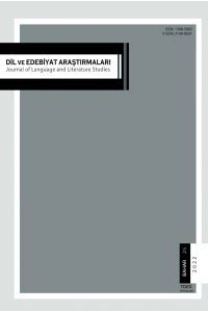Beyond Binary: Rethinking Orthographic Depth Through the Lens of Turkish Orthography
Beyond Binary: Rethinking Orthographic Depth Through the Lens of Turkish Orthography
Orthographic Depth Hypothesis, Turkish Orthography, Grapheme-Phoneme Correspondence, Phonemic Vowel Length Intermediate Orthography.,
___
- Abu-Rabia, S. (2001). The role of vowels in reading Semitic scripts: Data from Arabic and Hebrew. Reading and Writing: An Interdisciplinary Journal, 14(1-2), 39-59.
- Adams, M. J. (1990). Beginning to read: Thinking and learning about print. MIT Press.
- Altun, H. O. (2010). Düzeltme işareti ve Türkçede yazıldığı gibi okunmayan kelimeler. Atatürk Üniversitesi Türkiyat Araştırmaları Enstitüsü Dergisi, 17(43), 167-179.
- Aro, M., & Wimmer, H. (2003). Learning to read: English in comparison to six more regular orthographies. Applied Psycholinguistics, 24(4), 621-635.
- Atasoy, F. O. (2023). Türkçede yabancı kelime, ıstılah ve özel isimlerin imlası. RumeliDE Dil ve Edebiyat Araştırmaları Dergisi, (32), 343-357.
- Caravolas, M. (2004). Spelling development in alphabetic writing systems: A cross-linguistic perspective. European Psychologist, 9(1), 3-14.
- Caravolas, M. (2022). Reading and reading disorders in alphabetic orthographies. In M. J. Snowling, C. Hulme, & K. Nation (Eds.), The science of reading: A handbook (pp. 327-353). Blackwell.
- Cossu, G., Shankweiler, D., Liberman, I. Y., Katz, L., & Tola, G. (1988). Awareness of phonological segments and reading ability in Italian children. Applied Psycholinguistics, 9(1), 1-16.
- Demiriz, H. N., & Okur, A. (2019). Orthographic depth and orthographic depth of Turkish language. Modern Journal of Language Teaching Methods, 9(1), 42-51.
- Durgunoğlu, A. Y., & Öney, B. (1999). A cross-linguistic comparison of phonological awareness and word recognition. Reading and Writing, 11, 281-299.
- Ehri, L. C. (2005). Development of sight word reading: Phases and findings. In M. J. Snowling & C. Hulme (Eds.), The science of reading: A handbook (pp. 135-154). Blackwell.
- Frost, R., Katz, L., & Bentin, S. (1987). Strategies for visual word recognition and orthographical depth: A multilingual comparison. Journal of Experimental Psychology: Human Perception and Performance, 13(1), 104-115.
- Goswami, U., & Bryant, P. (1990). Phonological skills and learning to read. Psychology Press.
- İskender, H. (2008). Vowel-zero alternation in Turkish [Unpublished master’s thesis]. Boğaziçi University.
- İskender, H. (2015). The phonology of Arabic loanwords in Turkish: The case of t-palatalisation [Unpublished doctoral dissertation]. SOAS, University of London.
- İskender, H. (2021). A case of absolute neutralization in Turkish: T-Palatalization and its predictability. Zemin, (2), 78-111.
- Katz, L., & Frost, R. (1992). The reading process is different for different orthographies: The orthographic depth hypothesis. In R. Frost & L. Katz (Eds.), Orthography, phonology, morphology, and meaning (pp. 67-84). Elsevier.
- Kaya, M. (2004). Üniversite öğrencilerinin Türkçede yanlış ünlü sesletimleri. HAYEF Journal of Education, 1(1), 89-97.
- Kenstowicz, M. (1994). Phonology in generative grammar. Blackwell.
- Ladefoged, P., & Johnson, K. (2015). A course in phonetics (7th ed.). Cengage Learning.
- Landerl, K., Wimmer, H., & Frith, U. (1997). The impact of orthographic consistency on dyslexia: A German-English comparison. Cognition, 63(3), 315-334.
- Öney, B., & Durgunoğlu, A. Y. (1997). Beginning to read in Turkish: A phonologically transparent orthography. Applied Psycholinguistics, 18(1), 1-15.
- Özsoy, A. S. (2004). Türkçenin yapısı I: Sesbilim. Boğaziçi Üniversitesi Yayınevi.
- Patel, T. K., Snowling, M. J., & de Jong, P. F. (2004). A cross-linguistic comparison of children learning to read in English and Dutch. Journal of Educational Psychology, 96(4), 785-97.
- Perfetti, C., & Helder, A. (2022). Progress in reading science: Word identification, comprehension, and universal perspectives. In M. J. Snowling, C. Hulme, & K. Nation (Eds.), The science of reading: A handbook (pp. 5-35). Blackwell.
- Saiegh-Haddad, E. (2003). Linguistic distance and initial reading acquisition: The case of Arabic diglossia. Applied Psycholinguistics, 24(3), 431-51.
- Seymour, P. H. K., Aro, M., & Erskine, J. M. (2003). Foundation literacy acquisition in European orthographies. British Journal of Psychology, 94(2), 143-174.
- Share, D. L. (2008). On the Anglocentricities of current reading research and practice: The perils of overreliance on an ‘outlier’ orthography. Psychological Bulletin, 134(4), 584-615.
- Stanovich, K. E. (1980). Toward an interactive-compensatory model of individual differences in the development of reading fluency. Reading Research Quarterly, 15(1), 32-71.
- Torppa, M., Georgiou, G. K., Niemi, P., Lerkkanen, M.-K., & Poikkeus, A.-M. (2017). The precursors of double dissociation between reading and spelling in a transparent orthography. Annals of Dyslexia, 67, 42-62.
- Treiman, R. (1991). Phonological awareness and its roles in learning to read and spell. In D. J. Sawyer & B. J. Fox (Eds.), Phonological awareness and reading: The evolution of current perspectives (pp. 159-189). Springer Verlag.
- Turgay, T. (2020). Classifier constructions of Turkish [Unpublished doctoral dissertation]. Boğaziçi University.
- Türk Dil Kurumu. (2021). Yazım kılavuzu. Türk Dil Kurumu Yayınları.
- Venezky, R. L. (1970). The structure of English orthography. De Gruyter Mouton.
- Ziegler, J. C., Bertrand, D., Tóth, D., Csépe, V., Reis, A., Faísca, L., Saine, N., Lyytinen, H., Vaessen, A., & Blomert, L. (2010). Orthographic depth and its impact on universal predictors of reading: A cross-language investigation. Psychological Science, 21(4), 551-559.
- ISSN: 1308-5069
- Yayın Aralığı: 2
- Başlangıç: 2010
- Yayıncı: TÜRKİYE DİL VE EDEBİYAT DERNEĞİ
Yunus Emre’nin Meşhur ve Meçhul Bir Şiiri Üzerine Bazı Mülahazalar
XVIII. Yüzyılın Bilinmeyen Şairlerinden Nâdî ve Şiirleri
3-6 Yaş Çocuklarına Yönelik Resimli Hikâye Kitaplarının Korunma Haklarına Göre Analizi
Muhammet Übeydullah ÖZTABAK, Duygu YALMAN POLATLAR
16. Yüzyıla Ait Satır Altı Farsça-Türkçe Sözlük
Servet-i Fünûn Şairi Cenab Şahabeddin’in Geliştirdiği Mizah Felsefesi
Humour and Sadness in Postcolonial Novel: Emotional Ambivalence in Early Anglo-Indian Novels
